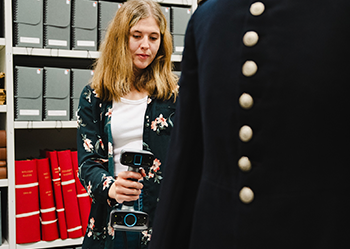University News Last updated 10 October 2024

A unique exhibition featuring human avatars wearing digitally reproduced police uniforms from as far back as 1839 will launch in Birmingham at the end of the year.
The project – fittingly called Fashion Police – will see gaming, technology and fashion students from Birmingham City University (BCU) join forces with the West Midlands Police Museum.
“By investigating the digital cultural heritage, we’re learning about the people who wore the uniforms, and the perceptions connected to them, including, family, victims, and perpetrators,” said Professor Carlo Harvey, BCU subject lead in the College of Computing.
“We’re helping people understand the police through the stories behind the uniforms.”
While video game and fashion students recreate 24 historically important police uniforms, from the original 1839 Peelers uniform to modern day garments, computing experts will develop meta human ‘avatars’ by examining interviews and historical documents.
The uniforms and avatars will then feature in an exhibition at the West Midlands Police Museum to give unprecedented access to the archived uniforms.
The project is made possible by National Lottery players through a grant of £247,000 from The National Lottery Heritage Fund.
Corinne Brazier, the Museum’s Heritage Manager, said: “It’s so exciting to see the stories and photographs come alive and move around as digital avatars.
“By using technology to showcase history in this exciting new way, we can help people to connect with the characters and understand who they were and what they went through.
“Our relationship with BCU’s College of Computing and College of Jewellery, Fashion and Textiles is giving students real experience of working to a brief and tailoring products to produce something that's high quality for the museum.”
A fashion show featuring 11 uniforms will launch the exhibition in November 2024. Gaming students will also create a digital version for people to watch using virtual reality.
“Being involved in research is essential for our students,” added Professor Harvey. “They put on gloves and learn how to interact with heritage pieces. The experience boosts their employability.”
Tasha Wicks, BA (Hons) Costume Design and Practice graduate, is a garment technologist working on the project.
“I’m interested in costumes and historical dress,” said Tasha, who aspires to work with museums on conservation projects. “I’m gaining great experience for a role in this area.
“The garments tell their own story about what life was like for the person who wore them.
“Deconstructing how the first female police uniform was made and looked has given a glimpse into what it was like for these women and how their role differed from that of male officers.
“From the lock-up matron – pre-dating the first female officer – to the 1960s senior female officer, and modern-day riot gear, we see real progression in the role and cultural attitudes.”
Anshita Adhikari, a BSc Visual Effects graduate from BCU, is now a texture artist.
“I add the texture to the 3D models created by fashion students,” she said. “I do this by matching and procedurally creating the fabrics, ensuring they are historically accurate.
“I fell in love with texturing when I was introduced to it. I had no idea that I could become part of this digital world. I hope the experience I gain from this project will help me launch my career.”
Nick Fletcher, BA (Hons) Fashion Design graduate, has a background in re-enactment.
“Archiving historical garments gives you an understanding of how people worked and lived,” he said. “By looking at textiles, we can tell what people had and what the weather was like.
“My experience in costume design, focusing on men’s tailoring and military wear, is invaluable. By looking at photos, I’m able to work out how things go together and recreate the garments.